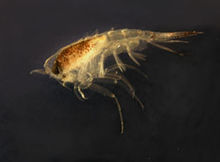Themisto (crustacean)
| Themisto | |
|---|---|
 | |
| Themisto gaudichaudii, the type species | |
| Scientific classification | |
| Domain: | Eukaryota |
| Kingdom: | Animalia |
| Phylum: | Arthropoda |
| Class: | Malacostraca |
| Superorder: | Peracarida |
| Order: | Amphipoda |
| Suborder: | Hyperiidea |
| Family: | Hyperiidae |
| Genus: | Themisto Guérin, 1825 |
| Synonyms | |
| Euthemisto Bovallius, 1887 | |
Themisto is a genus of marine amphipods in the family Hyperiidae.[1] Their distribution is cosmopolitan.[2]
Ecological role[edit]
Themisto are obligate carnivores. Themisto gaudichaudii has been found to feed opportunistically on copepods and chaetognaths, as juveniles also on diatoms.[3]
Themisto are important prey in many food webs. For example, Themisto gaudichaudii reaches high densities (up to 61 individuals/m3) in Kerguelen waters and is a major food item for blue petrels, thin-billed prions, Antarctic prions, common diving petrels, and southern rockhopper penguins.[4] In the Barents Sea, Themisto libellula is very abundant in the Arctic waters and important food item for cod, polar cod, and marine mammals near the ice edge, whereas Themisto abyssorum is important in Atlantic/boreal waters.[5]
Life history[edit]
Themisto gaudichaudii matures at lengths between 6 and 12 mm (0.24 and 0.47 in) or more. Reproduction can be nearly continuous but becomes more seasonal at higher latitudes. The offspring emerging from the marsupium are 2–3 mm (0.079–0.118 in) in length.[3] Themisto abyssorum has a life span of 1–2 years and reaches a maximum length of 18 mm (0.71 in). Themisto libellula lives 2–3 years and grows to a maximum length of 31 mm (1.2 in).[6]
Species[edit]
There are seven recognized species:[1]
- Themisto abyssorum (Boeck, 1870)
- Themisto australis (Stebbing, 1888)
- Themisto compressa Goës, 1865
- Themisto gaudichaudii Guérin, 1825
- Themisto japonica (Bovallius, 1887)
- Themisto libellula (Lichtenstein in Mandt, 1822)
- Themisto pacifica (Stebbing, 1888)
References[edit]
- ^ a b Gasca R, Zeidler W, Costello M, Bellan-Santini D (2013). Lowry J (ed.). "Themisto Guérin, 1825". World Amphipoda database. World Register of Marine Species. Retrieved 22 July 2016.
- ^ James K. Lowry (2003). "Hyperiidae". Crustacea: Malacostraca. Peracarida : Amphipoda, Cumacea, Mysidacea. Volume 19.2B of Zoological catalogue of Australia. CSIRO Publishing. pp. 307–316. ISBN 978-0-643-06902-2.
- ^ a b Watts, Jamie; Tarling, Geraint A. (2012). "Population dynamics and production of Themisto gaudichaudii (Amphipoda, Hyperiidae) at South Georgia, Antarctica". Deep-Sea Research Part II: Topical Studies in Oceanography. 59/60: 117–129. Bibcode:2012DSRII..59..117W. doi:10.1016/j.dsr2.2011.05.001.
- ^ Bocher, P.; Cherel, Y.; Labat, J. P.; Mayzaud, P.; Razouls, S.; Jouventin, P. (2001). "Amphipod-based food web: Themisto gaudichaudii caught in nets and by seabirds in Kerguelen waters, southern Indian Ocean". Marine Ecology Progress Series. 223: 261–276. Bibcode:2001MEPS..223..261B. doi:10.3354/meps223261.
- ^ Johannesen, E.; Ingvaldsen, R. B.; Bogstad, B.; Dalpadado, P.; Eriksen, E.; Gjøsæter, H.; Knutsen, T.; Skern-Mauritzen, M.; Stiansen, J. E. (2012). "Changes in Barents Sea ecosystem state, 1970–2009: climate fluctuations, human impact, and trophic interactions". ICES Journal of Marine Science. 69 (5): 880–889. doi:10.1093/icesjms/fss046.
- ^ Koszteyn, J.; Timofeev, S.; Węsławski, J. M.; Malinga, B. (1995). "Size structure of Themisto abyssorum Boeck and Themisto libellula (Mandt) populations in European Arctic seas". Polar Biology. 15 (2): 85–92. doi:10.1007/BF00241046. S2CID 12251703.


 French
French Deutsch
Deutsch